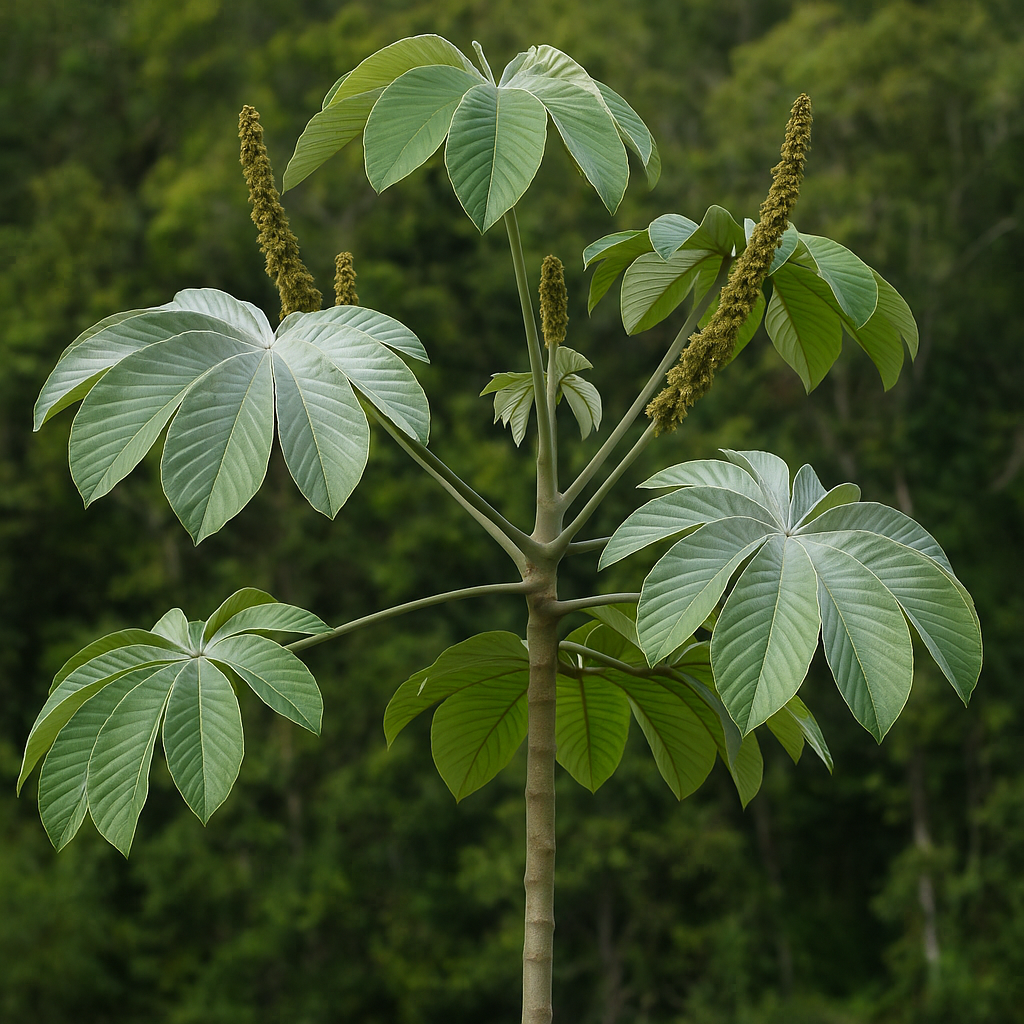The Silver Cecropia (Cecropia pachystachya) is a tropical tree native to Brazil and other parts of South America, known for its ecological importance and striking appearance. With large, palmate leaves that are silvery on the underside—hence its name—this species plays a crucial role in forest regeneration and wildlife support.
Botanical Features of Silver Cecropia
Silver Cecropia is a fast-growing tree from the Urticaceae family, typically reaching heights between 8 and 15 meters. Its trunk is hollow and segmented, a unique characteristic that plays a vital role in its relationship with ants.
The tree’s leaves are large, with deep lobes and a silver sheen on the underside that helps reflect sunlight and retain moisture. This distinct foliage makes it easy to spot in forest edges and open areas.
Its small white flowers grow in elongated clusters, and the fruits are soft, sweet, and clustered—highly attractive to various animals, especially fruit-eating birds and bats.
A Pioneer Species in Forest Restoration
Silver Cecropia is classified as a pioneer species, meaning it is among the first to colonize degraded or open land. Thanks to its rapid growth and tolerance for poor soils, it helps prepare the environment for other plant species by stabilizing the soil, offering shade, and enriching the organic matter.
This makes it a strategic ally in reforestation and ecological restoration projects, particularly in tropical regions where deforestation has left vast areas of bare land. As its leaves fall and decompose, they improve soil structure and nutrient availability.
A Fascinating Symbiosis with Ants
One of the most remarkable aspects of the Silver Cecropia is its mutualistic relationship with ants, particularly of the Azteca genus. These ants live inside the tree’s hollow stems, where they find shelter and feed on sugary secretions produced by the tree.
In return, the ants defend the Cecropia from herbivorous insects and even prune nearby vegetation that might compete for light. This natural partnership showcases the complex and efficient interactions within tropical ecosystems.
A Magnet for Wildlife
The Cecropia’s fruits are rich in sugars and water, making them an essential food source for many animals, including toucans, tanagers, thrushes, fruit bats, monkeys, and especially three-toed sloths. Sloths are often seen feeding on Cecropia leaves and resting among its branches, making this tree vital to their survival.
By attracting such a wide variety of fauna, Silver Cecropia contributes to the biodiversity of the ecosystem and helps disperse seeds of other plant species, further accelerating forest recovery.
Traditional Medicinal Uses
In folk medicine, Silver Cecropia leaves are used to prepare teas and infusions believed to treat respiratory issues such as asthma, bronchitis, and cough. Some traditions also credit the plant with anti-inflammatory and diuretic properties.
However, it’s important to note that these uses are based on traditional knowledge and should not replace medical advice. Scientific studies on the medicinal properties of Cecropia are ongoing and should be consulted before any therapeutic use.
Distribution and Cultivation
Silver Cecropia naturally thrives in secondary forests, riverbanks, and disturbed areas throughout South America, especially in the Atlantic Forest and Cerrado biomes. It prefers full sun and tolerates acidic, sandy, or nutrient-poor soils, making it highly adaptable.
Its propagation is typically done by seeds, and direct sowing is ideal at the start of the rainy season. In agroforestry and permaculture systems, it is valued for providing natural shade, improving soil health, and attracting wildlife.
A Tree Full of Purpose
Whether in the wild or in ecological restoration projects, Silver Cecropia serves multiple functions. It stabilizes ecosystems, attracts biodiversity, supports wildlife, and even contributes to traditional medicine. It stands as a living example of how a single species can positively impact an entire environment.
By learning about and promoting native trees like Cecropia pachystachya, we take an active role in supporting sustainable forestry and protecting the rich natural heritage of tropical regions.

Amazon Series Keracai Restorative Leave-In Treatment – 8.5 oz
Revitalize and protect your hair with this powerful leave-in treatment, enriched with natural ingredients for deep restoration and shine.
Buy Now on AmazonAmazon Series Keracai Restorative Leave-In Treatment – 8.5 oz
Revitalize and protect your hair with this powerful leave-in treatment, enriched with natural ingredients for deep restoration and shine.
Learn More
